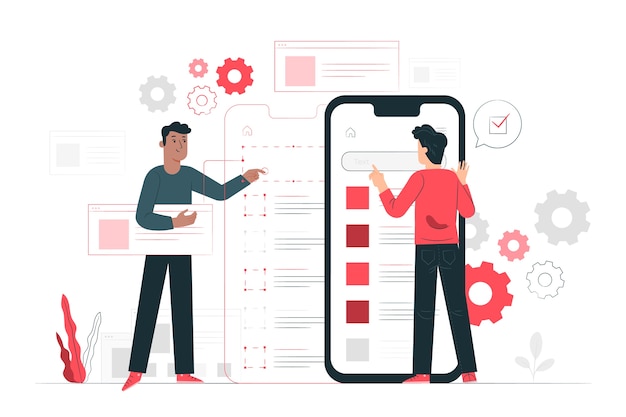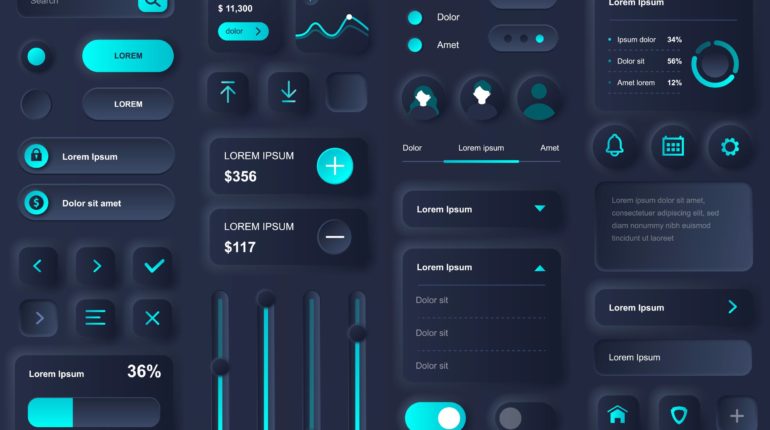UI Design – All You Need To Know
ALL YOU NEED TO KNOW ABOUT UI DESIGN

The user interface is the user engaging front-end device view to use the program. The user will use the user interface to manipulate and monitor both software and hardware. Today, almost anywhere in modern technology, from computers to cell phones, vehicles, music players, airplanes and ships, etc. can be found a user interface. The UI is a component of the app and is designed to provide the software’s user insight. UI design offers a key forum for interaction between humans and machines. Depending on the underlying hardware and software mix, UI can be graphic, text-based, audio-video based. UI could be hardware or software, or both.
The app becomes more common if the user interface is:
- Attractive
- Simple to operate
- Short-term response
- Understandable
- Compatible for all displays.
- UI design is divided into two groups in large measure:
- The interface of the Command Line
Command Line Interface (CLI)
CLI was an excellent tool for computer interaction before video screens were created. Many technical users and programmers choose CLI as their first preference. CLI is the minimum device interface available to its users. The command prompt, where the user types the command and feeds it into the device, has been provided by CLI. The user must recall the command syntax and its use. In previous CLIs, the user errors were not adequately treated. A command is a text-based reference to a series of instructions that the machine should execute. Methods such as macros, scripts make the process simple for the user. In comparison with GUI, CLI uses fewer machine resources.
CLI Elements:
The following elements can be found on a text-based command-line interface:
- Prompt command – It is a text notifier that indicates the user’s working context. The software system is generated.
- Cursor – It is a small horizontal line or a vertical line height bar that represents character position while typing. The cursor can be found mainly in blinking conditions. The user moves when something is written or deleted.
- Command – The executable command has been executed. There could be one parameter or more. The exit of the executive order is shown on the screen inline. The command prompt appears on the next line when output is made.
Graphical UI Design (GUI)
Graphical User Interface offers the device interaction graphical means. Both hardware and software can be combined with GUI. The program is interpreted by the user using GUI. In general, GUI consumes more resources than CLI. The programmers and designers develop complex GUI designs with advanced technology that works with greater performance, accuracy, and speed.
GUI Elements:
GUI offers a number of device or hardware interaction components. Each graphic aspect gives the system a way to operate. The following elements are included in the GUI system:
- Window – An environment in which application contents are seen. In case that the window represents the file structure, the contents of a window can be displayed by icons or lists. A user can navigate more easily through a scanning window in the file system. It is possible to reduce Windows, resize or max to the screen height. You can switch it on the computer anywhere. Another window, known as the child window, can contain the same application.
- Tabs – If an application permits many instances to be executed by itself, it appears as separate windows on the computer. Multiple documents have been opened in the same windows in Tabbed Document Interface. This GUI also allows displaying the application’s preferences screen. This functionality is used by all modern web browsers.
- Menu – Menu is a set of standard commands that are collected and put in the application window in a prominent position (usually top). The menu can be set to appear or hide by clicking on the mouse.
- Icon – The icon representing a related program is a small image. The application window is opened when these icons are clicked or double-clicked. The icon shows apps and programs installed in the form of small images on a system.
- Cursor – GUI cursors are represented by Interacting devices like the mouse, touchpad, and digital pen. The hardware instructions are followed by the screen cursor in nearly real-time. In GUI systems, cursors are also called points. The menus, windows, and other device functions are selected.
Application-specific GUI components
A GUI of an application contains one or more of the listed GUI elements:
- Application Window – Most application windows use the operating system constructs, although many use windows built by their own customers to contain the application’s material.
- Dialog Box – A children’s window which contains the user’s message and requests for action. For example: Create a dialogue to receive user confirmation to delete a file. for example.
- Text-Box – provides user area for entering text-based data and typing.
- Buttons – They image the buttons in real life and are used for machine inputs.
- Radio-button – Range displays open. Of all provided, only one can be chosen.
- Check-box – List-box-like features. The box is marked as marked when an option is selected. The checkboxes will pick several choices.
- List-box – Provides a selection list of products available. You can pick more than one object.
Additional components of GUI are:
- Slider
- Multi-Box
- Grid of data
- List of drops
Design activities of the UI Design

A variety of user interface design tasks are carried out. The design and development method of GUI is the same as SDLC. Any model can be used in Waterfall, Iterative, or Spiral models for GUI execution.
These GUI specific steps should be carried out by a model used for GUI design and creation:
- GUI Collecting Specifications – Programmers should provide a list of both functional and non-functional GUI requirements. The consumer and its current software solution will take it.
- User Analysis – The designer studies who will use the GUI app. The target audience is essential as the specifics of the interface change according to the user’s level of knowledge and skill. Users who are technically knowledgeable will implement advanced and complicated GUIs. More details about how to use apps are provided for a beginner user.
- Task Analysis – Designers must consider the tasks the software solution has to perform. No matter how this is done here in GUI. Tasks can be hierarchically interpreted by the main job and further divided into smaller sub-tasks. Tasks set GUI presentation targets. The flow of information between subtasks influences the flow of the software’s GUI content.
- GUI Design & Implementation – Designer’s design GUI, code-designing and embedding GUI with running, manipulative and stupid applications following details on specifications, tasks, and setting. The developers then test it for themselves.
- Testing- GUI testing can be conducted in different ways. Organization, direct user interaction, and release of the beta version of a small number of them are possible in-house inspections. Usability, compatibility, acceptance, etc can require testing.
Tools to implement GUI

Several tools are available that enable designers to build a whole GUI with a click of the mouse. Certain tools can be incorporated into the software environment (IDE). A strong collection of GUI controls is provided by GUI implementation tools. Designers may modify the code accordingly while customizing the program. Depending on their different use and platform, there are different GUI segments.
Example:
Mobile graphics, GUI computer, touch screen graphical interface, etc. Here is a list of some tools that are useful in building GUI:
- FLUID
- AppInventor (Android)
- LucidChart
- Wavemaker
- Visual Studio
UI Design Golden rules
Shneiderman and Plaisant defined in their book the following rules as the golden rules for GUI design (Designing the User Interface).
- Consistency efforts – Consistent action sequences in similar circumstances should be needed. In prompts, menus, and support screens the same language should be used. Consistent commands can be used all over the place.
- Allow regular users to use shortcuts — The desire of the consumer to reduce the number of usage-related interactions increases. Abbreviations, feature keys, secret commands, and macro devices are very useful for a knowledgeable user.
- Provide insightful feedback – System feedback should be provided for each operator operation. The response must be moderate in case of frequent and minor actions, while the response must be more substantial for infrequent and significant actions.
- Closing Design Dialog – Activities sequences in groups of start, center, and end should be ordered. The informative input at the conclusion of a group of acts provides operators with the gratification of achievement, the sense of relaxation, the message for dropping contingency plans and options from their minds.
- Provide quick error management – build the system as much as possible so that the user doesn’t make a significant mistake. The system should be able to detect an error and provide clear, understandable error management mechanisms.
- Allow fast action reversal – This function relieves fear because users are aware that bugs can be reversed. Simple reversal allows unfamiliar solutions to be explored. The reversibility units may be one operation, one entry of data, or a whole series of steps.
- The support for the internal control locus – Experienced operators strongly want the system to be controlled and the system to react. Design the method to make consumers rather than respondents the initiators of behavior.
- Reduce short-run load memory – Limiting human information processing in short-run memory includes plain views, consolidating multiple-page displays, reducing the pace of the window movement, and allocation of enough time for codes, mnemonics, and behavior.
Principle of Consistency and Standards in UI Design

Two main reasons for consistency and UI design standards are needed to follow. When designing the user interface, the relationship between human knowledge and the screen for which you are designed should be taken into account. To help users do stuff better means that they are not forced to learn new representations or resources for every job. Reducing the length of thought by uncertainty removal is also a sure bet to improve user experience.
- Reduce education
Coherence reduces the number of representations of actions and operations, making sure that users do not learn new representations for each task. In addition, the setting of design standards like following platform conventions enables users to perform new tasks without learning a whole new toolkit. This may sound like a straightforward idea, but several examples show a lack of continuity in their designs. The Xfinity website by Comcast Corporation, a US mass media company, is an example of this problem. Not only when the user clicks on another tab, the secondary menu is incoherent in their website but is also incoherent in the primary menu.
- Confusion removal
Users tend and have some preferences, to follow the rules they have learned outside of your website or product. Knowing that, let us be aware that when we deviate from design norms and traditions, we cause uncertainty and alienation. Furthermore, users should not waste time asking if sentences, interactions, or behaviors in the sense of your product really mean the same thing. Confusion happens when individuals cannot ‘piece’ knowledge together and sometimes hinder anything from being achieved. It is understandable that if the consumer is prevented from the achievement of his objective, they might feel angry or upset, it’s understandable. It is no secret, that uncertainty usually frustrates and leads to a bad user experience. There is no secret. Therefore, any touchpoint wherever possible should always be aimed at eliminating uncertainty.
Five different ways to achieve coherence in UI Design
Inside the user interface, there are several aspects to ensure consistency. Here are five things you will see to make your designs more consistent:
- Your language choice
You can not only affect the users’ understanding of the product through their vocabulary used both in ads as well as in wording used in the user flux, but also be confounded by using different terms for the same purpose. This does not only affect the words, but also the tone with which the message is transmitted.
When visiting a website that has a generally friendly tone, you scar for your user with a critical and threatening error message you will certainly ruin an otherwise successful user experience. When it’s the same or the same thing, it should be shown like it is in the email system of Google, Gmail. Gmail files are called ‘Inbox,’ ‘Drafts,’ ‘Send Mail’ etc. depending on the organizational style of client e-mail applications. This terminology is familiar and consistent to anyone who has used email applications in the past.
- As originally defined, apply UI elements
UI elements commonly used, including message windows, menu bars, icons, scroll bars, and radio buttons, are usually graphical elements with user-friendly representations. For example, if only one choice is allowed, radio buttons must be used. Only if the user is permitted with more than one choice can checkboxes be used on the other. We can see how HTML5 has beaten Flash technology by the end of 2014 in many respects. One of the reasons is that the developers, designers, and users will benefit from the constancy and standards of HTML5 in defining their UI elements with ease of implementation and ease of use. In the comment section on the BBC news site in the past, we find a poor example of consistency in the choice of UI components. A south-facing arrow is a higher-ranking user comment but users can click on the north-facing arrow to improve their rating of comments.
To increase the rating of comments, users have to press the north-facing arrow. It is also unintuitive to use a south-facing arrow to reflect the highest rating comments. When users scan the comment section of a web page, they should simply behave according to the arrows, not reading action labels. If the user does not use traditional visual representations, he or she can deliberately engage the user interface in an unpleasant way that decreases the speed they can navigate and perform the desired tasks.
- In determining layout, consider many well-established Conventions.
Whether a designer “clones” the way others set out their websites or software is definitely debatable. However, it is important for users to remember that people have a good memory for the objects on the screen, given the perspective and intellect of the user. This feature can be used by reserving widely used positions for different graphical features, including the search field in the top-left, the exit icon in the top-right, and so on.
- Build for the needs of your customer
Make sure that you have the functionality and features that people want your site to view. For instance, a ticket booking system for the airline site should exist whereas a media player should have a music-sharing site.
- Make graphics compatible on your site
Enforce consistency of visual elements on your web. The material should be in harmony and should feel compatible with the IT elements, fonts, backgrounds, and colors. As discussed above, it is one way to maintain continuity to adhere to the technical conventions in the form of HTML5 and CSS3. In the meantime, it helps to adopt a branding and style guide in the face of design choices including colors and fonts.
The 2013 edition of Google Gmail’s mobile UI design gives a poor example of continuity in the choice of colors and fonts. While it can be argued that “context” in that case isn’t affected, it is undeniably because of some odd disparity in visual components between the displays that user experience almost always worsens.
6 UI Design Guidelines
These are the golden six thumb rules to follow for the User Interface design: –
- Device status visibility: Users should be told in a reasonable amount of time of device operations that are easily understood and highly visible on the computer.
- Compatibility between the real world and the system: Designers should strive to represent the vocabulary and ideas that consumers in the real world find based on who they are their target users. Presenting users’ perceptions from real-world interactions in a logical order and piggybacking can reduce the stress of cognition and facilitate the use of systems.
- Regulation of the consumer and liberty: It provides users with the possibility of retroactive measures, including the removal and re-doing of past actions.
- Coherence and norms: Interface designers are responsible for maintaining graphic components and terminology across similar platforms. For example, if an icon is used on another screen that represents one category or definition, it does not represent a different concept.
- Preventing Errors: Plan structures to minimize potential errors, wherever possible. Users do not want problems that often go beyond their knowledge to be identified and corrected. Removing or flagging acts that may lead to mistakes are two potential ways to avoid mistakes.
- Recognition instead of recalling: Minimize the cognitive load by preserving task-relevant data within the display during device exploration. Human care is minimal and we can only keep five things simultaneously in our short-term memory. Because of the short-term memory constraint, programmers should ensure that users are able to use recognition rather than retrieve information in all parts of the dialogue. It is often easier to recognize anything than to remember because recognition involves perceiving indications that help us access our vast memory and allow relevant information to surface. For example, we also find the multiple-choice questions format simpler than short answers to test questions because it needs only that we know the response rather than remember it.
The Takeaway
Consistency and standards are recognized as an integral design concept and should be implemented in the product’s content and interactions. The quality of our designs includes the vocabulary we use, the UI design items we use, the way we set out our site, the functions and functionalities we incorporate, and the visual components we decide on, such as the color and font. The following factors can be considered.
Consistency tends to maximize user experience by preventing excessive user learning and misunderstanding. It is important to note that if possible you can use it but do not allow it to limit you to innovate on design concepts that are meaningful. It should be something you will benefit from following rules and conventions and being consistent. You are free from relatively trivial design choices. This helps you save time and free your mind so that your templates and user experience can be enhanced for your customers.

